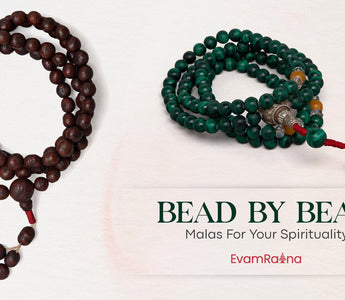Malas Are A Global Symbol of Spirituality
A string of prayer beads, traditionally called Malas, is a spiritual tool. These sacred cords are more than just accessories. They serve as powerful aids for meditation, mantra chanting, and spiritual growth. People from numerous religious backgrounds have continued to use them for spiritual practice and meditation for centuries.
This comprehensive guide will delve into their rich symbolism and uses to help you choose the perfect one to enhance your spiritual journey. Whether you are a seasoned practitioner or just beginning to explore spirituality, this guide will equip you with the knowledge and tools to harness the transformative power of these powerful prayer beads.
When exploring such prayer beads for meditation and spiritual practice, the materials used in their creation hold significant meaning and influence the practitioner's experience. They are traditionally crafted from a variety of natural materials, each imbued with its unique properties and symbolism.
Types Of Malas: Materials And Their Meanings
Malas are crafted from a variety of materials, each adding a unique touch and significance. The beads obtained from natural sources have been commonly used for both spiritual practices and jewelry purposes.
Nonetheless, the natural materials from where the prayer beads are routinely sourced are mentioned below:
- Wood
- Seeds
- Gemstones
- Bone
1. Wooden Malas
Wooden Malas are particularly made from sacred trees found in nature. They are revered for their grounding energy and connection to Mother Nature. Some of them are listed below:
- Sandalwood
- Rosewood
- Bodhi

Sandalwood malas is known for its calming aroma. They promote tranquility during meditation.
Meanwhile, rosewood malas are known for their deep, rich color and pleasant aroma. They are also believed to offer protection from negative energies and aid spiritual growth and development.
Bodhi tree malas are made from the wood of the Bodhi tree. Shakyamuni Buddha attained enlightenment under its shade, so this tree holds an esteemed significance in Buddhism. As such, prayer beads made from its wood hold significant spiritual symbolism.
2. Seeds Malas
Seed malas are another option on the list due to their spiritual significance and energetic properties. There exist various prayer beads sourced from natural seeds are mentioned below:
- Rudraksha
- Bodhichitta
- Tulsi
- Lotus
Rudraksha seeds are considered powerful tools for connecting with divine consciousness. The beads are believed to have protective properties that foster inner peace and balance. They are also known for their grounding and protective qualities.

The Bodhichitta seeds, made from the Ziziphus budhensis tree, is a highly revered spiritual tool in many Buddhist traditions. It has several beneficial properties, including stress reduction and protection from negative energies. Its ability to help with mental clarity during meditation also makes it a valuable tool.
Tulsi seeds is highly religiously significant to the Hindu community. It is associated with Goddess Lakshmi and Lord Krishna. Hence, it is believed that it enhances spiritual growth, purifies the mind, and protects against evil energies.
The Lotus flower is a symbol of purity, enlightenment, and rebirth in many cultures. Thus, a lotus seed mala is believed to promote spiritual growth, reduce stress, and enhance creativity.
3. Gemstones Malas

Gemstone Malas offers another layer of significance as they involve various gems obtained deep from the Earth. Each gemstone resonates with specific energies that can enhance meditation practices; thus, selecting a counting prayer bead made from particular stones can align one's intentions with the desired outcome of their practice. The following list includes some of the widely used gemstones and their uses:
- Amethyst: To purify the mind and clear negative energies.
- Rose Quartz: It is also called "stone of love." It is used to attract love, strengthen friendships, and deepen relationships.
- Clear Quartz: For clarity of mind, spiritual growth, and healing purposes. It also enhances the properties of other stones.
- Citrine: also called "merchant's stone" or "stone of abundance. It helps to attract prosperity, success, and wealth.
- Lapis Lazuli: It is used to enhance intellectual abilities, promote spiritual insight, and foster self-awareness.
- Turquoise: It is used for communication, self-expression, and balancing emotions.
- Onyx: It is used to absorb and transmute negative energies, promoting inner strength, stability, and resilience.
- Moonstone: It is used to enhance intuition, psychic abilities, and connection to the lunar cycle
- Black Tourmaline: It promotes grounding, stability, and purification of energy fields.
- Jade: It brings good luck and facilitates emotional healing.
By incorporating specific gemstones into a prayer bead, one can amplify their intentions and connect with the energies that resonate with particular needs.
4. Bone Malas
Bone malas are a unique type of prayer bead made from animal bones. They are used in certain spiritual practices, particularly in Tibetan Buddhism. While their use is not as widespread as other types, they hold significant symbolism and meaning for those who choose to use them.

Symbolism and Meanings:
- Impermanence: The use of bone in prayer beads serve as a constant reminder of the impermanence of life. Bones are a tangible symbol of mortality, and using them can help to cultivate a sense of detachment and non-attachment.
- Transformation: The transformation of animal bones into a beautiful and meaningful object can symbolize the potential for spiritual transformation and rebirth.
- Strength and Resilience: Bones are associated with strength and resilience, representing the ability to overcome challenges and persevere.
- Protection: Some believe that bone prayer beads offer protection from negative energies and harmful influences.
The choice of material not only influences the aesthetic appeal but also serves to deepen one's spiritual journey. By understanding these materials' meanings and energies, practitioners can select a counting beads that resonates deeply with their personal intentions and enhances their meditative experience.
Apart from being visually appealing, they should aid one's personal spiritual journey. Therefore, it is very important to understand the components, materials, and symbolism of such beads to enhance the intention behind their use and the depth of meditation practice.
How To Choose The Right Mala For Your Practice?
The process of selecting mala beads is profoundly personal and reflective of one's journey and intentions in meditation. Choosing the right counting beads for your meditation and spiritual practice is a deeply personal journey, as each mala carries its own unique energy and significance.
Take a closer look at the following steps to find the right Japa Mala for your next journey to a spiritual world:
- Materials
- Number of Beads
- Aesthetic Appeal
- Research your Mantra
1. Materials
When selecting a prayer bead string, consider the materials from which it is made. Traditional malas often feature beads crafted from natural substances, each holding distinct properties that can enhance your practice. For instance, sandalwood is revered for its calming qualities, while amethyst is known for promoting clarity and spiritual growth.
2. Number of Beads
After carefully considering your choice of material, reflect on the number of beads in the string. The most common count is 108 beads, a number imbued with spiritual significance in various traditions. However, there are also shorter malas with 27 or 54 beads for shorter practices available in the market. This choice can influence the rhythm of your meditation and how you connect with your intentions.
While the 108 beads in a string is the most common one, it is a spiritually significant number relevant to specific religious traditions. Make your choice depending on personal preferences and the intentions you wish to bring to your meditation practice.
3. Aesthetic Appeal
Aesthetics can play a crucial role in how you feel during your practice; choose colors or patterns that resonate with you personally. Lastly, think about whether you want a tassel at the end of your mala. This element can serve as a focal point during meditation and symbolizes enlightenment. Hence, you can consider the design and aesthetic appeal of the Japa mala. This alignment is crucial for achieving states of deep meditation and enlightenment.
4. Research your Mantra
Apart from choosing the aesthetics, materials, and the number of beads in the string, it is essential to note what mantra to chant during the meditation. You can choose a mantra under the guidance of a spiritual leader or research a holy figure to please the entity. Make sure that the prayer beads and the mantra resonate to make up your mind for the practice to get the desired state of mind.
Ultimately, trust your intuition before and after selecting a counting bead string. Go for one that speaks to you and will deepen your connection to both your practice and yourself. Whether you are focusing on grounding energy, enhancing peace and compassion, or promoting clarity, selecting malas with intention will deepen the connection to your practice.
















URL-https://www.servpujastore.in/
Bhakti aur nature dono ka blend hai yeh natural wooden mala.
I noticed there was no information about green malachite gemstone malas. Which mantra and diety prattice are they best for?
I noticed there was no information about green malachite gemstones. Which mantra and diety prattice are they best for?